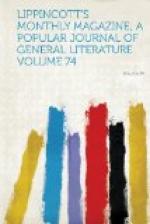and Dr. Howe, as from the belief that Santo Domingo,
if once made our territory, would soon enrich our
treasury from its commerce and its uncommon adaptability
as a watering-place. We have spoken of this book
as very thorough. It is so in every respect—historical,
pictorial and narrative. The list of books pertaining
to the subject occupies alone eight pages of small
print: as the author, however, evidently wishes
this list to be approximately complete, and as he
seems to be aware of but few books except those in
the British Museum, we will oblige him, as possibly
useful for a future edition, with the titles of some
which he does not give: one of these especially,
Dr. Brown’s History and Present Condition
of St. Domingo, we are surprised he does not include,
as it is one of the most popular and useful books
on the topic, and a manual of which we imagined every
commissioner to have got a chapter by heart daily when
on the way to Samana:
Las Casas, “Destruccion de las Indias,” Sevilla, 1552; Desportes, “Histoire des Maladies de Saint Domingue,” Paris, 1770, 3 vols.; Petit, “Droit Publique des Colonies Francaises” (containing the “Black Code"), Paris, 1777; Nicolson, “Histoire Naturelle de Saint Domingue,” Paris, 1776; Valverde, “Idea del Valor de la Isla Espanola,” Madrid, 1785; Puysegur, “Navigation aux Cotes de St. Domingue,” Paris, 1787; D’Auberteuil, “Considerations sur la Colonie, etc.,” 1776; Coulon, “Troubles en Saint Domingue,” 1798; Malouet, fourth volume of his “Colonial History,” 1802; Dubroca, “Toussaint l’Ouverture,” 1802; Tonnerre, “Memoires, Histoire d’Haiti,” Port-au-Prince, 1804; Laujon and Montpenay, “Precis,” 1805, 1811, 1814 and 1819; Bercy, “De St. Domingue,” Paris, 1814; Herard Dumesle, “Voyage,” Port-au-Prince, 1824; Clausson, “Revolution de Saint Domingue,” 1819; Malo, “Histoire d’Haiti,” Paris, 1825; Wallez, “Biography of General Boyer,” 1826; Macaulay, “Abolition d’Esclavage,” 1835; J. Brown, M.D., “History and Present Condition of Saint Domingo,” 1837; Chaucheprat, “Le Routier des Antilles,” 1843; Schoelcher, “Resultats de l’emancipation anglaise,” 1843; Emile Nau, “Histoire des Caciques d’Haiti,” 1855; Saint-Amand, “Histoire des Revolutions d’Haiti,” Paris, 1860; Pradine (ex-minister to England), “Digest of Laws of Hayti,” Paris, 1860.
Thorvaldsen: his Life
and Works. From the French of Eugene
Plon, by I.M. Luyster.
Boston: Roberts Brothers.
Thorwaldsen’s life lasted from 1770 to 1844, and was very industrious. He was the son of a Copenhagen ship-carver, and received all his bent from the study of the antique in Italy. The works he left are almost innumerable, and some of them will have lasting reputation. The finest perhaps is his medallion of Night, “launched with infinite lightness into space, carrying in her arms her two children, Sleep and Death.” This masterpiece is said to have been conceived during a sleepless night in 1815, and modeled in one day. His Lion




